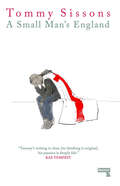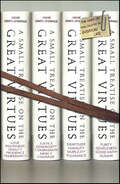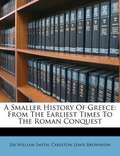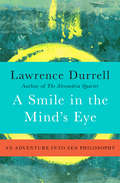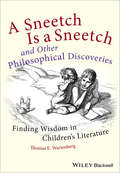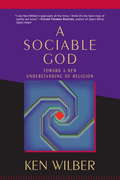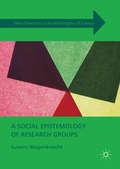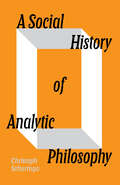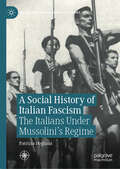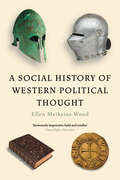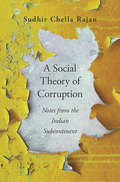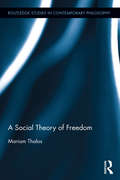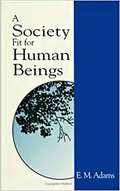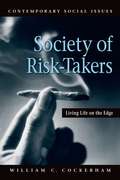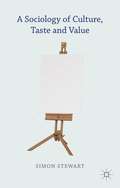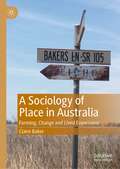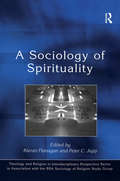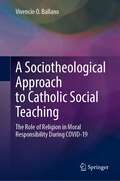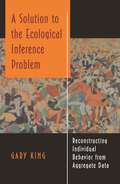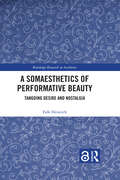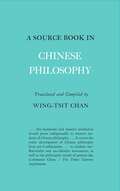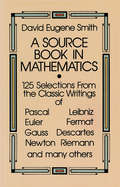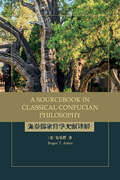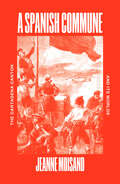- Table View
- List View
A Small Man's England
by Tommy SissonsAn exploration of white working-class English men, showing how and why some have been captured by the far-right and what the left can do about it.IS THE WHITE WORKING CLASS RIGHT-WING? AND IS IT RIGHT-WING TO EVEN SPEAK OF A "WHITE WORKING CLASS"? In recent decades, as class consciousness has been suppressed and eroded, many white working-class men have turned their backs on the left in favour of the right and the far-right. Why is this? A Small Man's England is a polemic aimed at the structures of hierarchy that ceaselessly maintain power across Britain and elsewhere, and a call for multicultural solidarity amongst the working class. In analysing the roles that class, race, masculinity and nationality play in neoliberal Britain, Sissons offers a solution to the indoctrination of white working-class English men by the right and the far-right, and explores how working-class people can collectively shape a "Common England" -- a country based on equality and justice for all.
A Small Treatise on the Great Virtues: The Uses of Philosophy in Everyday Life
by André Comte-SponvilleAn utterly original exploration of the timeless human virtues and how they apply to the way we live now, from a bold and dynamic French writer.In this graceful, incisive book, writer-philosopher André Comte-Sponville reexamines the classic human virtues to help us under-stand "what we should do, who we should be, and how we should live." In the process, he gives us an entirely new perspective on the value, the relevance, and even the charm of the Western ethical tradition.Drawing on thinkers from Aristotle to Simone Weil, by way of Aquinas, Kant, Rilke, Nietzsche, Spinoza, and Rawls, among others, Comte-Sponville elaborates on the qualities that constitute the essence and excellence of humankind. Starting with politeness -- almost a virtue -- and ing with love -- which transcs all morality -- A Small Treatise on the Great Virtues takes us on a tour of the eighteen essential virtues: fidelity, prudence, temperance, courage, justice, generosity, compassion, mercy, gratitude, humility, simplicity, tolerance, purity, gentleness, good faith, and even, surprisingly, humor.Sophisticated and lucid, full of wit and vivacity, this modestly titled yet immensely important work provides an indispensable guide to finding what is right and good in everyday life.
A Smaller History of Greece: from the Earliest Times to the Roman Conquest
by William SmithThe literary education of a Spartan youth was of a most restricted kind. He was taught to despise literature as unworthy of a warrior,while the study of eloquence and philosophy, which were cultivated at Athens with such extraordinary success, was regarded at Sparta with contempt. <P> <P> -from Chapter IV Intended for school use, this 1865 abridgement of Smith's more comprehensive History of Greece is an excellent introduction to classical history for readers of all ages. <P> <P> From the geography and distant origins of the Greek nation and culture to the Greek colonies and Persian and Peloponnesian Wars through the conquests of Alexander the Great, this clear, concise, highly readable work is a pocket-size Greek history for antiquity buffs to treasure and refer to again and again. British classicist and lexicographer SIR WILLIAM SMITH (1813¬-1893) was editor of the Quarterly Review, and also wrote Dictionary of Greek and Roman Antiquities (1842), Dictionary of Greek and Roman Biography and Mythology (1849), and Dictionary of Greek and Roman Geography (1857).
A Smile in the Mind's Eye: An Adventure into Zen Philosophy
by Lawrence DurrellThe &“virtuoso&” author&’s memoir of his spiritual journey with famed Taoist philosopher Jolan Chang (The New York Times). Beginning with their first meeting over lunch at Lawrence Durrell&’s Provencal home, Durrell and Jolan Chang—renowned Taoist philosopher and expert on Eastern sexuality—developed an enduring relationship based on mutual spiritual exploration. Durrell&’s autobiographical rumination on their friendship and on Taoism recounts the author&’s existential ponderings, starting with his introduction to the mystical and enigmatic &“smile in the mind&’s eye.&” From parsimony, cooking, and yoga to poetry, Petrarch, and Nietzche, A Smile in the Mind&’s Eye is a charming tale of a writer&’s spiritual and philosophical awakening.
A Sneetch is a Sneetch and Other Philosophical Discoveries
by Thomas E. WartenbergTaking Picture Books Seriously: What can we learn about philosophy through children's books?This warm and charming volume casts a spell on adult readers as it unveils the surprisingly profound philosophical wisdom contained in children's picture books, from Dr Seuss's Sneetches to William Steig's Shrek!. With a light touch and good humor, Wartenberg discusses the philosophical ideas in these classic stories, and provides parents with a practical starting point for discussing philosophical issues with their children. Accessible and multi-layered, it answers questions like, Is it okay for adults to deceive kids? What's the difference between saying the Mona Lisa is a great painting and vanilla is your favorite flavor? Each chapter includes illustrations commissioned especially for this book.
A Sociable God: Toward a New Understanding of Religion
by Ken Wilber Roger WalshIn one of the first attempts to bring an integral dimension to sociology, Ken Wilber introduces a system of reliable methods by which to make testable judgments of the authenticity of any religious movement. A Sociable God is a concise work based on Wilber's "spectrum of consciousness" theory, which views individual and cultural development as an evolutionary continuum. Here he focuses primarily on worldviews (archaic, magic, mythic, mental, psychic, subtle, causal, nondual) and evaluates various cultural and religious movements on a scale ranging from egocentric to ethnocentric to worldcentric to Kosmic. By using this integral view, Wilber hopes, society would be able to discriminate between dangerous cults and authentic spiritual paths. In addition, he points out why these distinctions are crucial in understanding spiritual experiences and altered states of consciousness. In a lengthy new introduction, the author brings the reader up to date on his latest integral thinking and concludes that, for the succinct and elegant way it argues for a sociology of depth, A Sociable God remains a clarion call for a greater sociology.
A Social Epistemology of Research Groups: Collaboration In Scientific Practice (New Directions in the Philosophy of Science)
by Susann WagenknechtThis book investigates how collaborative scientific practice yields scientific knowledge. At a time when most of today's scientific knowledge is created in research groups, the author reconsiders the social character of science to address the question of whether collaboratively created knowledge should be considered as collective achievement, and if so, in which sense. Combining philosophical analysis with qualitative empirical inquiry, this book provides a comparative case study of mono- and interdisciplinary research groups, offering insight into the day-to-day practice of scientists. The book includes field observations and interviews with scientists to present an empirically-grounded perspective on much-debated questions concerning research groups' division of labor, relations of epistemic dependence and trust.
A Social History of Analytic Philosophy
by Christoph SchuringaHow a supposedly apolitical form of philosophy owes its continuing power to social and political forcesAnalytic philosophy is the leading form of philosophy in the English-speaking world. What explains its continued success? Christoph Schuringa argues that its enduring power can only be understood by examining its social history. Analytic philosophy tends to think of itself as concerned with eternal questions, transcending the changing scenes of history. It thinks of itself as apolitical. This book, however, convincingly shows that the opposite is true.The origins of analytic philosophy are in a set of distinct movements, shaped by high-ly specific sets of political and social forces. Only after the Second World War were these disparate, often dynamic movements joined together to make &‘analytic philosophy&’ as we know it. In the climate of McCarthyism, analytic philosophy was robbed of political force.To this day, analytic philosophy is the ideology of the status quo. It may seem arcane and largely removed from the real world, but it is a crucial component in upholding liberalism, through its central role in elite educational institutions. As Schuringa concludes, the apparently increasing friendliness of analytic philosophers to rival approaches in philosophy should be understood as a form of colonization; thanks to its hegemonic status, it reformats all it touches in service of its own imperatives, going so far as to colonize decolonial efforts in the discipline.
A Social History of Italian Fascism: The Italians Under Mussolini’s Regime (Italian and Italian American Studies)
by Patrizia DoglianiThis book uncovers how fascism reshaped Italian society according to its ideological and historical interpretation of the Italian nation and people and identifies the strengths of this transformation, but also the resistance encountered from, for example, women and minority groups, to accept it in everyday life. It analyzes the success achieved by some policies aimed at popular masses in order to integrate them into the nation, and how fascism initiated an early welfare state project to address specific categories of society such as veterans, families, mothers and children. The book also questions the concept and practices of social citizenship reserved only for those who gave evidence of formal adherence to fascism.
A Social History of Western Political Thought
by Ellen Meiksins WoodA sweeping and nuanced materialist history of Western political thoughtIn this groundbreaking work, Ellen Meiksins Wood rewrites the history of political theory, from Plato to Rousseau. Treating canonical thinkers as passionately engaged human beings, Wood examines their ideas not simply in the context of political languages but as creative responses to the social relations and conflicts of their time and place. She identifies a distinctive relation between property and state in Western history and shows how the canon, while largely the work of members or clients of dominant classes, was shaped by complex interactions among proprietors, labourers and states. Western political theory, Wood argues, owes much of its vigour, and also many ambiguities, to these complex and often contradictory relations. In the first volume, she traces the development of the Western tradition from classical antiquity through to the Middle Ages in the perspective of social history—a significant departure not only from the standard abstract history of ideas but also from other contextual methods. From the Ancient Greek polis of Plato, Aristotle, Aeschylus and Sophocles, through the Roman Republic of Cicero and the Empire of St Paul and St Augustine, to the medieval world of Averroes, Thomas Aquinas and William of Ockham, Wood offers a rich, dynamic exploration of thinkers and ideas that have indelibly stamped our modern world. In the second volume, Wood addresses the formation of the modern state, the rise of capitalism, the Renaissance and Reformation, the scientific revolution and the Age of Enlightenment, which have all been attributed to the &“early modern&” period. Nearly everything about its history remains controversial, but one thing is certain: it left a rich and provocative legacy of political ideas unmatched in Western history. The concepts of liberty, equality, property, human rights and revolution born in those turbulent centuries continue to shape, and to limit, political discourse today. Assessing the work and background of figures such as Machiavelli, Luther, Calvin, Spinoza, the Levellers, Hobbes, Locke and Rousseau, Ellen Wood vividly explores the ideas of the canonical thinkers, not as philosophical abstractions but as passionately engaged responses to the social conflicts of their day.
A Social Theory of Corruption: Notes From The Indian Subcontinent
by Sudhir Chella RajanA social theory of grand corruption from antiquity to the twenty-first century.In contemporary policy discourse, the notion of corruption is highly constricted, understood just as the pursuit of private gain while fulfilling a public duty. Its paradigmatic manifestations are bribery and extortion, placing the onus on individuals, typically bureaucrats. Sudhir Chella Rajan argues that this understanding ignores the true depths of corruption, which is properly seen as a foundation of social structures. Not just bribes but also caste, gender relations, and the reproduction of class are forms of corruption.Using South Asia as a case study, Rajan argues that syndromes of corruption can be identified by paying attention to social orders and the elites they support. From the breakup of the Harappan civilization in the second millennium BCE to the anticolonial movement in the late nineteenth and early twentieth centuries, elites and their descendants made off with substantial material and symbolic gains for hundreds of years before their schemes unraveled.Rajan makes clear that this grander form of corruption is not limited to India or the annals of global history. Societal corruption is endemic, as tax cheats and complicit bankers squirrel away public money in offshore accounts, corporate titans buy political influence, and the rich ensure that their children live lavishly no matter how little they contribute. These elites use their privileged access to power to fix the rules of the game—legal structures and social norms—benefiting themselves, even while most ordinary people remain faithful to the rubrics of everyday life.
A Social Theory of Freedom (Routledge Studies in Contemporary Philosophy)
by Mariam ThalosIn A Social Theory of Freedom, Mariam Thalos argues that the theory of human freedom should be a broadly social and political theory, rather than a theory that places itself in opposition to the issue of determinism. Thalos rejects the premise that a theory of freedom is fundamentally a theory of the metaphysics of constraint and, instead, lays out a political conception of freedom that is closely aligned with questions of social identity, self-development in contexts of intimate relationships, and social solidarity. Thalos argues that whether a person is free (in any context) depends upon a certain relationship of fit between that agent’s conception of themselves (both present and future), on the one hand, and the facts of their circumstances, on the other. Since relationships of fit are broadly logical, freedom is a logic—it is the logic of fit between one’s aspirations and one’s circumstances, what Thalos calls the logic of agency. The logic of agency, once fleshed out, becomes a broadly social and political theory that encompasses one’s self-conceptions as well as how these self-conceptions are generated, together with how they fit with the circumstances of one’s life. The theory of freedom proposed in this volume is fundamentally a political one.
A Society Fit For Human Beings (Suny Series In Constructive Postmodern Thought Ser.)
by E. M. AdamsArgues for a humanistic cultural reformation to counter our materialistic values and science-dominated intellectual life and shows how this would affect our lives and transform our society.
A Society Of Risk-Takers: Living Life On The Edge
by William C. CockerhamWhat causes an individual to be a risk-taker? In this timely and provocative new book, William C. Cockerham provides an up-to-date sociological examination of risk takers and risk taking processes through the lens of some of America's most dangerous behaviors: sexually transmitted diseases, alcohol, drug use, smoking, and extreme sports. Not content with simply discussing these subjects, Cockerham also creates an original and innovative risk response model designed to advance the sociological analysis of risk takers. Society of Risk-Takers can be incorporated into a variety of courses in sociology, social problems, culture and society, and medical sociology.
A Sociology of Culture, Taste and Value
by Simon StewartThis book explores sociological debates in relation to culture, taste and value. It argues that sociology can contribute to debates about aesthetic value and to an understanding of how people evaluate.
A Sociology of Place in Australia: Farming, Change and Lived Experience
by Claire BakerThis book weaves a social, economic and cultural history of Australia with rare first-hand accounts of the lived experience of change related to farming and agriculture. It provides a rich sociology of how living on the land has changed throughout Australia’s history. The book investigates the complex effects of the state on everyday life, using an historical agricultural case study of place to explore long-running sociohistorical processes of change examined through both a macro and micro sociological lens. This provides a multi-faceted perspective from which to examine economic, social and cultural transformations in each of these contexts and change is examined through multiple sites of expression: public policy and the role of the state; colonial processes of dispossession; social and cultural systems of value; economic change and its consequences; farming practices and lived experience; neoliberalism and globalisation and their social impacts; community decline and trends toward corporate and foreign land ownership. Each of these transformations impact upon lived experience and everyday life and this book provides grounded insight into exactly this relationship and process.
A Sociology of Spirituality (Theology and Religion in Interdisciplinary Perspective Series in Association with the BSA Sociology of Religion Study Group)
by Peter C. JuppThe emergence of spirituality in contemporary culture in holistic forms suggests that organised religions have failed. This thesis is explored and disputed in this book in ways that mark important critical divisions. This is the first collection of essays to assess the significance of spirituality in the sociology of religion. The authors explore the relationship of spirituality to the visual, individualism, gender, identity politics, education and cultural capital. The relationship between secularisation and spirituality is examined and consideration is given to the significance of Simmel in relation to a sociology of spirituality. Problems of defining spirituality are debated with reference to its expression in the UK, the USA, France and Holland. This timely, original and well structured volume provides undergraduates, postgraduates and researchers with a scholarly appraisal of a phenomenon that can only increase in sociological significance.
A Sociotheological Approach to Catholic Social Teaching: The Role of Religion in Moral Responsibility During COVID-19
by Vivencio O. BallanoThis book introduces Catholic social teaching (CST) and its teaching on the common good to the reader and applies them in the realm of public health to critically analyze the major global issues of COVID-19 that undermine public interest. It uses the sociotheological approach that combines the moral principles of CST and the holistic analysis of modern sociology and also utilizes the secondary literature as the main source of textual data. Specifically, it investigates the corporate moral irresponsibility and some unethical business practices of Big Pharma in the sale and distribution of its anti-COVID vaccines and medicines, the injustice in the inequitable global vaccine distribution, the weakening of the United States Congress’s legislative regulation against the pharmaceutical industry’s overpricing and profiteering, the inadequacy of the World Health Organization’s (WHO) law enforcement system against corruption, and the lack of social monitoring in the current public health surveillance system to safeguard the public good from corporate fraud and white-collar crime. This book highlights the contribution of sociology in providing the empirical foundation of CST’s moral analysis and in crafting appropriate Catholic social action during the pandemic. It is hoped that through this book, secular scholars, social scientists, religious leaders, moral theologians, religious educators, and Catholic lay leaders would be more appreciative of the sociotheological approach to understanding religion and COVID-19. “This book brings into dialogue two bodies of literature: documents of Catholic social teaching, and modern sociology and its core thinkers and texts...The author does especially well to describe how taking ‘the sociotheological turn’...will benefit the credibility and dissemination of Catholic social thought.”- Rev. Fr. Thomas Massaro, S.J., Professor of Moral Theology, Jesuit School of Theology, Santa Clara University, Berkeley, California.
A Solution to the Ecological Inference Problem: Reconstructing Individual Behavior from Aggregate Data
by Gary KingThis book provides a solution to the ecological inference problem, which has plagued users of statistical methods for over seventy-five years: How can researchers reliably infer individual-level behavior from aggregate (ecological) data? In political science, this question arises when individual-level surveys are unavailable (for instance, local or comparative electoral politics), unreliable (racial politics), insufficient (political geography), or infeasible (political history). This ecological inference problem also confronts researchers in numerous areas of major significance in public policy, and other academic disciplines, ranging from epidemiology and marketing to sociology and quantitative history. Although many have attempted to make such cross-level inferences, scholars agree that all existing methods yield very inaccurate conclusions about the world. In this volume, Gary King lays out a unique--and reliable--solution to this venerable problem. King begins with a qualitative overview, readable even by those without a statistical background. He then unifies the apparently diverse findings in the methodological literature, so that only one aggregation problem remains to be solved. He then presents his solution, as well as empirical evaluations of the solution that include over 16,000 comparisons of his estimates from real aggregate data to the known individual-level answer. The method works in practice. King's solution to the ecological inference problem will enable empirical researchers to investigate substantive questions that have heretofore proved unanswerable, and move forward fields of inquiry in which progress has been stifled by this problem.
A Somaesthetics of Performative Beauty: Tangoing Desire and Nostalgia (Routledge Research in Aesthetics)
by Falk HeinrichThis book develops an original theory of performative beauty. Philosophical aesthetics has largely neglected one’s own actions as a potential experience of the beautiful. Throughout the book, the author uses his own experiences of Argentine tango as a case study; one important incentive for social dancing is to have pleasurable and beautiful experiences. This book begins by investigating the methodological causes for why beauty in modernity has been seen to result only from contemplating external objects. It then builds a theory of performative beauty that incorporates findings from new phenomenology, neuroaesthetics, enactivism, and somaesthetics and that reassesses existing inquiries of beauty. The result is an account that identifies kinaesthetic awareness as the point of emergence of both theory and practice, of creation (poiesis) and perception (aisthesis), and of moving (agency) and being moved (reception). Performative beauty is the pleasure of being moved by the dance where the dancer feels both as a creative improvisor and as an integrated part of the activity itself. A Somaesthetics of Performative Beauty—Tangoing Desire and Nostalgia will appeal to scholars and advanced students working in aesthetics, dance studies, performance studies, and related fields of artistic research.
A Source Book In Chinese Philosophy
by Wing-Tsit Chan<P>China has changed more in the twentieth century than in any period in her history. <P>She has overthrown a 3,000-year-old monarchic system.<P> She has replaced the 1,300-year-old examination institution with modern education.<P> Men and women are for the first time equal.
A Source Book in Chinese Philosophy
by Wing-Tsit ChanA Source Book in Chinese Philosophy is a milestone along the complex and difficult road to significant understanding by Westerners of the Asian peoples and a monumental contribution to the cause of philosophy. It is the first anthology of Chinese philosophy to cover its entire historical development. It provides substantial selections from all the great thinkers and schools in every period--ancient, medieval, modern, and contemporary--and includes in their entirety some of the most important classical texts. It deals with the fundamental and technical as well as the more general aspects of Chinese thought. With its new translation of source materials (some translated for the first time), its explanatory aids where necessary, its thoroughgoing scholarly documentation, this volume will be an indispensable guide for scholars, for college students, for serious readers interested in knowing the real China.
A Source Book in Mathematics
by David Eugene SmithThis work presents, in English translation, the great discoveries in mathematics from the Renaissance to the end of the nineteenth century. You are able to read the writings of Newton, Leibniz, Pascal, Riemann, Bernoulli, and others, exactly as the world saw them for the first time. Succinct selections from 125 different treatises and articles, most of them unavailable elsewhere in English, offer a vivid, firsthand story of the growth of mathematics.
A Sourcebook in Classical Confucian Philosophy (SUNY series in Chinese Philosophy and Culture)
by Roger T. AmesApplies a method of comparative cultural hermeneutics to let the tradition speak on its own terms.Roger T. Ames's A Sourcebook in Classical Confucian Philosophy is a companion volume to his Conceptual Lexicon for Classical Confucian Philosophy. It includes texts in the original classical Chinese along with their translations, allowing experts and novices alike to make whatever comparisons they choose. In applying a method of comparative cultural hermeneutics, Ames has tried to let the tradition speak on its own terms. The goal is to encourage readers to move between the translated text and commentary, the philosophical introduction that attempts to sensitize them to the interpretative context, and the companion Lexicon of key philosophical terms, with the expectation that in the fullness of time they will be able to appropriate the original Chinese terminologies themselves. Armed with their own increasingly robust insight into these philosophical terms, readers will be able to carry this nuanced understanding over into their critical reading of other available translations. Ultimately, for students who would understand Chinese philosophy, tian天must be understood as tian天, and dao道must be dao道.
A Spanish Commune: The Cartagena Canton and its Worlds
by Jeanne MoisandThe previously untold history of a powerful federalist revolution in Spain in 1873 and its links with the colonial and global social protests of its time.The Paris Commune had a little Spanish sister, the Canton of Cartagena, whose impressive and neglected history is unearthed in this book.In July 1873, thousands of men and women proclaimed a Commune, or &“Canton&”, in the south-eastern Spain military port of Cartagena. Their aim was to build a federal Republic &‘from below&’, while refusing to be sent to the colonial war in Cuba as soldiers or sailors. Confronted by the regular army and the intervention of the British Navy, they resisted for six months before finally surrendering in January 1874.This book shows the importance of this cantonal episode in the history of socialism and colonial emancipation. It gives a voice to categories neglected by the major accounts of the workers' movement&’s history: peasants, workers from southern Europe, conscripts and working-class women. It reveals unsuspected links between the Spanish drive towards a federal and social republic and the imaginaries of Atlantic abolitionism, and of workers' internationalism. It thus places Spain and its empire at the heart of the global history of revolutions.
